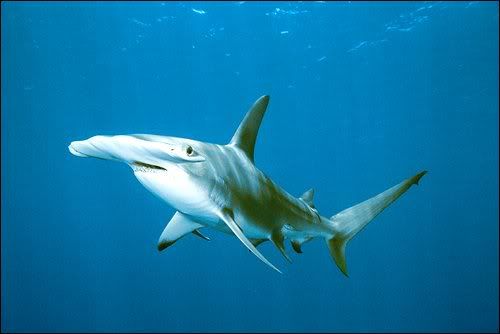|
|
Post by Revenge on Apr 14, 2009 8:52:48 GMT -5
Sharks
Shark Hallmarks: Although the great white shark is probably the most famous of this group of talented hunters and voracious eaters, sharks come in many different sizes, shapes and colors. In general, however, the torpedo-shaped body and sharp rows of teeth are the hallmarks of the shark.
Exceptions to the Rule: Some exceptions are the frill shark, a deepwater species, which resembles an eel more than a shark. Another variation is the pygmy shark, which grows no larger than 10 inches in length. The pygmy has light-producing organs on its belly and sides. It is thought that this its luminescence eliminates shadows, making this shark difficult to see when attacking its prey.
Hunting Techniques: Different species also depend on different tactics for hunting and killing. Some sharks rely on short high-speed chases. Other species prefer to wait for sedentary fish to come their way, and still others are scavengers on the look out for carcasses.
In Decline: The popularity of shark fishing and shark as food have had an impact on populations. About 100 million sharks are caught annually.
DID YOU KNOW?
Rapid Tooth Loss: Sharks are constantly growing new rows of teeth. The teeth — which are embedded in the flesh rather than attached to the jaw — are replaced about every eight days. A shark can lose up to 30,000 teeth in a lifetime.
Afraid of Dolphins?: Are sharks averse to dolphins? On an episode of Discovery Channel's Mythbusters, when a mechanical dolphin was placed near raw bait and a seal cutout, a feeding great white shark avoided both items, suggesting that they are.
Shark Evolution: Sharks have existed for over 400 million years. For most of that time, they were relatively small; it wasn't until the giant marine reptiles went extinct, and mammals evolved into aquatic forms, that large sharks emerged. [/blockquote] |
|
|
|
Post by Revenge on Apr 14, 2009 9:08:22 GMT -5
The Bull Shark
Bull Shark Profile
Bull sharks are aggressive, common, and usually live near high-population areas like tropical shorelines. They are not bothered by brackish and freshwater, and even venture far inland via rivers and tributaries.
Because of these characteristics, many experts consider bull sharks to be the most dangerous sharks in the world. Historically, they are joined by their more famous cousins, great whites and tiger sharks, as the three species most likely to attack humans.
Bull sharks get their name from their short, blunt snout, as well as their pugnacious disposition and a tendency to head-butt their prey before attacking. They are medium-size sharks, with thick, stout bodies and long pectoral fins. They are gray on top and white below, and the fins have dark tips, particularly on young bull sharks.
They are found cruising the shallow, warm waters of all the world’s oceans. Fast, agile predators, they will eat almost anything they see, including fish, dolphins, and even other sharks. Humans are not, per se, on their menus. However, they frequent the turbid waters of estuaries and bays, and often attack people inadvertently or out of curiosity.
Bull sharks currently are not threatened or endangered. However, they are fished widely for their meat, hides, and oils, and their numbers are likely shrinking. One study has found that their average lengths have declined significantly over the past few decades.
Bull Shark Range (In the yellow)

[/right] Fast Facts Type: Fish
Diet: Carnivore
Average lifespan in the wild: 16 years
Size: 7 to 11.5 ft (2.1 to 3.4 m)
Weight: 200 to 500 lbs (90 to 230 kg)
Group name: School or shoal
Did you know?: Bull sharks have been found thousands of miles up the Amazon River, and in Nicaragua have been seen leaping up river rapids, salmon-like, to reach inland Lake Nicaragua. Size relative to a 6-ft (2-m) man [/blockquote][/size] |
|
|
|
Post by Revenge on Apr 14, 2009 9:27:04 GMT -5
The Hammerhead Shark
Hammerhead Shark Profile
Hammerhead sharks are consummate predators that use their oddly shaped heads to improve their ability to find prey. Their wide-set eyes give them a better visual range than most other sharks. And by spreading their highly specialized sensory organs over their wide, mallet-shaped head, they can more thoroughly scan the ocean for food.
One group of sensory organs is the ampullae of Lorenzini, which allows sharks to detect, among other things, the electrical fields created by prey animals. The hammerhead's increased ampullae sensitivity allows it to find its favorite meal, stingrays, which usually bury themselves under the sand.
The great hammerhead is the largest of the nine identified species of this shark. It can grow up to 20 feet (6 meters) in length and weigh up to 1,000 pounds (450 kg), although smaller sizes are more common.
Found in temperate and tropical waters worldwide, far offshore and near shorelines, hammerheads are often seen in mass summer migrations seeking cooler water. They are gray-brown to olive-green on top with off-white undersides, and they have heavily serrated, triangular teeth. Their extra-tall, pointed dorsal fins are easily identifiable.
Most hammerhead species are fairly small and are considered harmless to humans. However, the great hammerhead's enormous size and fierceness make it potentially dangerous, though few attacks have been recorded.
Hammerhead populations are not accurately known, but appear stable worldwide, and they are not considered threatened.
Hammerhead Shark Range (in the yellow)
Fast Facts
Type: Fish
Diet: Carnivore
Average lifespan in the wild: 20 to 30 years
Size: 13 to 20 ft (4 to 6 m)
Weight: 500 to 1,000 lbs (230 to 450 kg)
Group name: School or shoal
Did you know?: Hammerheads use their wide heads to attack stingrays, pinning the winged fish against the sea floor.
Size relative to a 6-ft (2-m) man:
|
|
|
|
Post by Revenge on Apr 14, 2009 9:33:32 GMT -5
|
|








